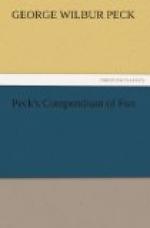The manufacture of cheese is a business that a poor man can engage in, as well as a rich man, I say it without fear of successful contradiction, and say it boldly, that a poor man with, say 200 cows, if he thoroughly understands his business, can market more cheese than a rich man with 300 oxen. This is susceptible of demonstration. If any boy showed a desire to become a statesman, I would say to him, “Young man, get married, buy a mooly cow, go to Sheboygan county, and start a cheese factory.”
Speaking of cows, did it ever occur to you, gentlemen, what a saving it would be to you if you should adopt mooley cows instead of horned cattle? It takes at least three tons of hay and a large quantity of ground feed annually to keep a pair of horns fat, and what earthly use are they? Statistics show that there are annually killed 45,000 grangers by cattle with horns. You pass laws to muzzle dogs, because one in ten thousand goes mad, and yet more people are killed by cattle horns than by dogs. What the country needs is more mooley cows.
Now that I am on the subject, it may be asked what is the best paying breed for the dairy. My opinion is divided between the south down and the cochin china. Some like one the best and some the other, but as for me, give me liberty or give me death.
There are many reforms that should be inaugurated in the manufacture of cheese. Why should cheese be made round? I am inclined to the belief that the making of cheese round is a superstition. Who had not rather buy a good square piece of cheese, than a wedge-shaped chunk, all rind at one end, and as thin as a Congressman’s excuse for voting back pay at the other? Make your cheese square and the consumer will rise up and call you another.
Another reform that might be inaugurated would be to veneer the cheese with building paper or clapboards, instead of the time-honored piece of towel. I never saw cheese cut that I didn’t think that the cloth around it had seen service as a bandage on some other patient. But I may have been wrong. Another thing that does not seem to be right, is to see so many holes in cheese. It seems to me that solid cheese, one made by one of the old masters, with no holes in it—I do not accuse you of cheating, but don’t you feel a little ashamed when you see a cheese cut, and the holes are the biggest part of it? The little cells may be handy for the skipper, but the consumer feels the fraud in his innermost soul.
Among the improvements made in the manufacture of cheese I must not forget that of late years the cheese does not resemble the grindstone as much as it did years ago. The time has been when, if the farmer could not find his grindstone, all he had to do was to mortise a hole in the middle of a cheese, and turn it and grind his scythe. Before the invention of nitro-glycerine, it was a good day’s work to hew off cheese enough for a meal. Time has worked wonders in cheese.




